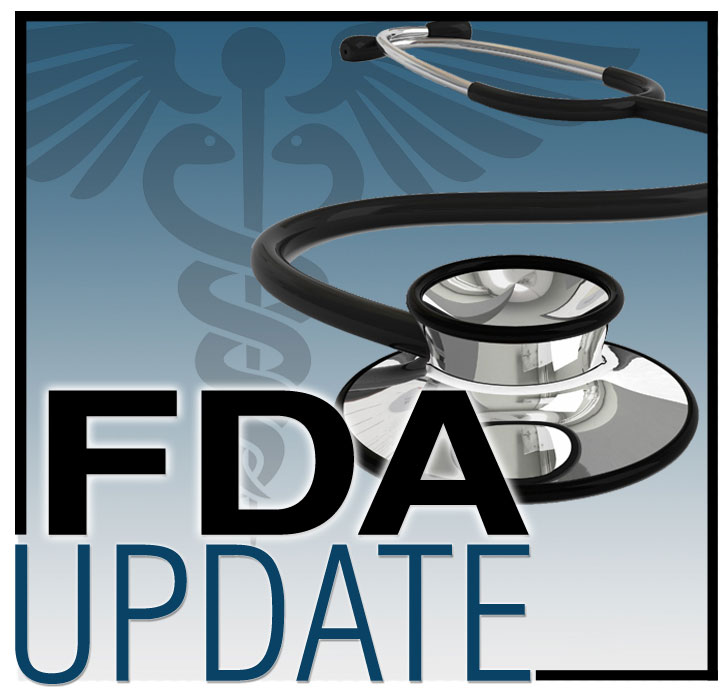FDA Approves Gemtuzumab Ozogamicin for CD33-Positive AML

On September 1, 2017, the U.S. Food and Drug Administration (FDA) approved gemtuzumab ozogamicin (Mylotarg, Pfizer Inc.) for the treatment of newly-diagnosed CD33-positive acute myeloid leukemia (AML) in adults and for treatment of relapsed or refractory CD33-positive AML in adults and in pediatric patients 2 years and older. Gemtuzumab ozogamicin may be used in combination with daunorubicin and cytarabine for adults with newly-diagnosed AML, or as a stand-alone treatment for certain adult and pediatric patients.
Approval of gemtuzumab ozogamicin in combination with chemotherapy for adults was based on ALFA-0701 (NCT00927498), a multicenter, randomized, open-label phase 3 study of 271 patients with newly-diagnosed, de novo AML aged 50 to 70 years. Patients were randomized (1:1) to receive induction therapy consisting of daunorubicin (60 mg/m2 on days 1 to 3) and cytarabine (200 mg/m2 on days 1 to 7) with (n=135) or without (n=136) gemtuzumab ozogamicin 3 mg/m2 (up to maximum of one vial) on days 1, 4, and 7. Using the per protocol definition of event-free survival (EFS), estimated median EFS was 17.3 months for patients receiving gemtuzumab ozogamicin vs. 9.5 months for those receiving chemotherapy alone, with hazard ratio of 0.56 (95% CI: 0.42, 0.76).
Gemtuzumab ozogamicin was evaluated in two clinical trials for use as a single agent. The first trial, AML-19, was a multicenter, randomized (1:1), open-label phase 3 study in 237 patients comparing gemtuzumab ozogamicin monotherapy to best supportive care (BSC). Eligible patients had newly-diagnosed AML and were 1) greater than 75 years of age or 2) 61 to 75 years of age with a WHO performance status greater than 2 or were unwilling to receive intensive chemotherapy. During induction, gemtuzumab ozogamicin 6 mg/m2 was given on day 1 and gemtuzumab ozogamicin 3 mg/m2 was given on day 8. Patients with no evidence of disease progression or significant toxicities after induction received continuation therapy as outpatients with up to 8 courses of treatment including gemtuzumab ozogamicin 2 mg/m2 on day 1, every 4 weeks. BSC included standard supportive care measures and hydroxyurea or other anti-metabolites for palliative purposes. Estimated median overall survival (OS) was 4.9 months for patients receiving gemtuzumab ozogamicin vs. 3.6 months for those receiving BSC, with hazard ratio of 0.69 (95% CI: 0.53, 0.90).
The second trial, MyloFrance-1, a phase 2, single-arm, open-label study, included 57 patients with CD33-positive AML in first relapse. Patients received a single course of gemtuzumab ozogamicin 3 mg/m2 on days 1, 4, and 7. Consolidation therapy consisted of cytarabine intravenously every 12 hours for 3 days. Fifteen (26%; 95% CI: 16% - 40%) patients achieved complete response (CR) following a single course of gemtuzumab ozogamicin. Median relapse-free survival, measured from the first documentation of CR to the date of relapse or death, was 11.6 months.
The label contains a box warning for hepatotoxicity. The most common adverse reactions (>15%) were hemorrhage, infection, fever, nausea, vomiting, constipation, headache, increased AST, increased ALT, rash, and mucositis. Serious adverse reactions associated with gemtuzumab ozogamicin are hepatotoxicity (including veno-occlusive disease), infusion-related reactions (including anaphylaxis), and hemorrhage.
This approval includes a lower recommended dose and schedule of gemtuzumab ozogamicin than what FDA approved previously in 2000, as well as a different patient population. Gemtuzumab ozogamicin was voluntarily withdrawn in 2010 after trials failed to confirm benefit and demonstrated safety concerns, including early mortality and VOD.
The full prescribing information is available (https://www.accessdata.fda.gov/drugsatfda_docs/label/2017/761060lbl.pdf).
FDA previously granted orphan drug designation to gemtuzumab ozogamicin. A description of FDA expedited programs is in the Guidance for Industry: Expedited Programs for Serious Conditions-Drugs and Biologics (http://www.fda.gov/downloads/drugs/guidancecomplianceregulatoryinformation/guidances/ucm358301.pdf).
Healthcare professionals should report all serious adverse events suspected to be associated with the use of any medicine and device to FDA’s MedWatch Reporting System by completing a form online (http://www.fda.gov/medwatch/report.htm), by faxing (1-800-FDA-0178) or mailing the postage-paid address form provided online, or by telephone (1-800-FDA-1088).
Follow the Oncology Center of Excellence on Twitter @FDAOncology (http://www.twitter.com/@fdaoncology).
Check out recent approvals at the OCE’s new podcast (http://www.fda.gov/DISCO), Drug Information Soundcast in Clinical Oncology (DISCO).
In collaboration with the FDA and as a service to our members, ONS provides updates on recent FDA approvals and other important FDA actions (e.g., updated safety information, new prescribing information) pertaining to therapies for patients with cancer. This allows the agency to inform oncologists and professionals in oncology-related fields in a timely manner. Included in the FDA updates is a link to the product label or to other sites for additional relevant clinical information. In supplying this information, ONS does not endorse any product or therapy and does not take any position on the safety or efficacy of the product or therapy described.
